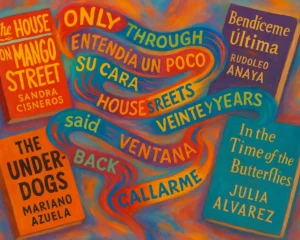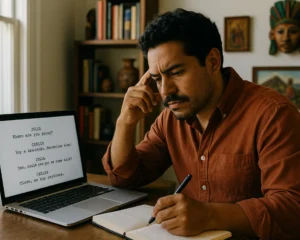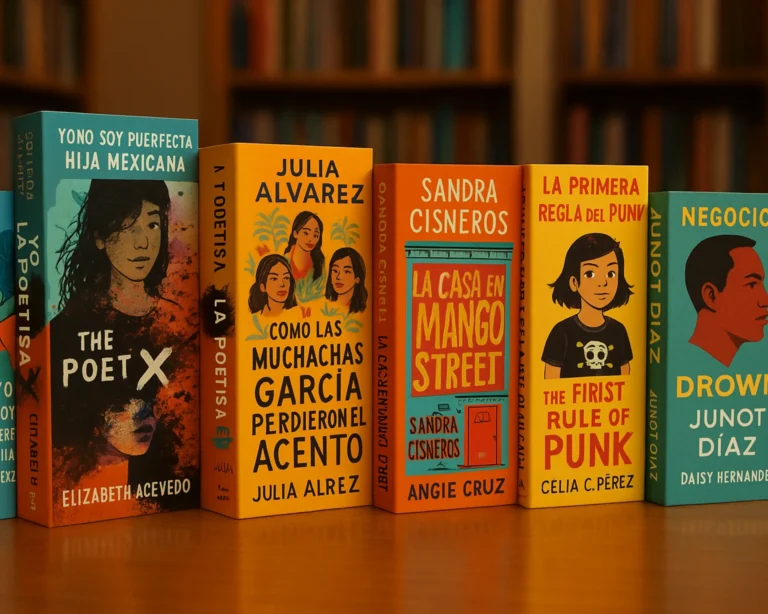Language is more than a tool for communication — it’s the heartbeat of culture, the keeper of memory, and the bridge between worlds. For Latinx writers, the choice of whether and how to incorporate Spanish into English-language work is deeply personal, politically charged, and creatively powerful. In an era where bilingual storytelling is experiencing a renaissance, writers are reclaiming their linguistic heritage and asserting that authentic Latinx voices don’t need to choose between languages — they can embrace both.
The question isn’t whether you should write bilingually, but rather how to do so in a way that honors your voice, serves your story, and connects with readers. From Sandra Cisneros’s poetic code-switching in “The House on Mango Street” to Junot Díaz’s unapologetic Spanglish in “The Brief Wondrous Life of Oscar Wao,” Latinx literature has long demonstrated that writing in two worlds isn’t a compromise — it’s a superpower.
The Power of Linguistic Authenticity
For generations, Latinx writers were told to translate, to explain, to make their Spanish palatable for English-speaking readers. Editors insisted on italicizing Spanish words, adding glossaries, or providing immediate translations that interrupted the narrative flow. The underlying message was clear: Spanish is foreign, other, something that needs to be marked and explained.
But contemporary Latinx writers are pushing back against these conventions. They’re writing characters who speak the way real bilingual people speak — fluidly moving between languages, code-switching mid-sentence, using Spanish words that don’t have perfect English equivalents. This linguistic authenticity creates characters and narratives that feel true to the lived experience of millions of Latinx people who navigate two languages daily.
When you write bilingually, you’re not just adding Spanish words for flavor or authenticity — you’re asserting that your readers, whether bilingual or not, can engage with language the way your characters do. You’re trusting that context, rhythm, and storytelling will carry meaning even when every word isn’t immediately understood. This trust creates a more immersive, authentic reading experience.
Understanding Code-Switching as Literary Technique
Code-switching — the practice of alternating between two or more languages within a single conversation or text — is a natural phenomenon for bilingual speakers. In literature, it’s a powerful technique that can reveal character, establish setting, create rhythm, and build intimacy between narrator and reader.
When Code-Switching Serves Your Story
Effective code-switching in literature isn’t random — it’s purposeful. Characters might switch to Spanish for terms of endearment, expressions of emotion, cultural concepts that don’t translate well, conversations with elders or family members, moments of stress or vulnerability, or assertions of cultural identity. Each language choice reveals something about the character, the moment, and the relationship.
Julia Alvarez masterfully demonstrates this in her work, seamlessly moving between English and Spanish in ways that reflect how her characters think and feel. The language shifts aren’t obstacles to understanding — they’re windows into the characters’ interior lives and cultural contexts. As discussed in our article on the role of culture in Latinx storytelling, language is one of the most powerful tools for expressing cultural identity.
The Rhythm and Music of Bilingual Prose
Spanish and English have different rhythms, different music. Spanish tends toward longer vowel sounds, more syllables, and a different cadence than English. When you weave both languages into your prose, you create a unique rhythm that can’t be achieved in either language alone. This musicality is part of what makes bilingual literature so distinctive and powerful.
Pay attention to how Spanish words and phrases affect the rhythm of your sentences. Sometimes a Spanish word provides exactly the right beat, the perfect pause, the necessary emphasis that an English equivalent wouldn’t achieve. Trust your ear — if it sounds right, if it feels authentic to how your characters would speak, then it is right.
Practical Approaches to Bilingual Writing
There’s no single “correct” way to incorporate Spanish into English-language writing, but there are several approaches that contemporary Latinx authors have used successfully. Your choice will depend on your audience, your story, your characters, and your own relationship with both languages.
The Immersive Approach
Some writers, like Junot Díaz, use Spanish extensively without translation, trusting readers to understand from context or to sit with the unfamiliarity. This approach treats Spanish as equal to English, refusing to other or explain it. It’s bold, unapologetic, and creates an immersive experience for bilingual readers while inviting monolingual readers to engage with language in new ways.
This approach works best when the Spanish is either understandable from context, when the exact meaning isn’t crucial to plot comprehension, or when you’re deliberately creating an experience of linguistic immersion. It asserts that your primary audience includes bilingual readers and that monolingual readers are welcome but not centered.
The Contextual Approach
Other writers provide context clues that allow readers to understand Spanish without explicit translation. A character might say something in Spanish, and another character’s response in English reveals the meaning. Or the narration might paraphrase or react to the Spanish dialogue in ways that convey the gist without translating word-for-word.
Sandra Cisneros often uses this technique, weaving Spanish into her prose in ways that feel natural while ensuring readers can follow the emotional and narrative arc. The Spanish adds flavor, authenticity, and cultural specificity without creating barriers to understanding. This approach balances accessibility with authenticity.
The Selective Approach
Some writers use Spanish selectively for specific purposes: cultural terms that don’t translate well (abuela, quinceañera, sobremesa), expressions of emotion (¡Ay, Dios mío!), terms of endearment (mi amor, mijo), or moments of cultural intimacy. This approach acknowledges that some concepts simply exist more fully in Spanish and that translation would diminish their meaning.
This is often the most accessible approach for readers with limited Spanish, as the Spanish words are typically either cognates, commonly known terms, or understandable from context. It allows you to honor your cultural heritage while maintaining broad accessibility. As explored in our guide on finding your voice as a Latinx writer, balancing authenticity with accessibility is a personal creative decision.
Handling Translation and Formatting Decisions
One of the most debated aspects of bilingual writing is how to handle translation and formatting. Should Spanish words be italicized? Should you provide translations? Where and how? These aren’t just technical questions — they’re political and artistic ones.
The Italics Debate
Traditionally, publishers italicized foreign words to mark them as “other.” Many contemporary Latinx writers reject this practice, arguing that Spanish isn’t foreign in Latinx literature — it’s integral. Authors like Esmeralda Santiago and Daniel Alarcón often write Spanish in regular roman type, treating it as equal to English.
Your choice about italics sends a message. Italicizing Spanish can help readers distinguish languages, especially in dialogue-heavy scenes. But it also others Spanish, marking it as different, foreign, not-quite-belonging. Consider what message you want to send and what serves your story best. According to Poets & Writers, many contemporary bilingual authors are moving away from italicizing Spanish as a political and artistic choice.
Translation Choices
If you choose to provide translations, you have several options. Immediate translation in parentheses or dialogue tags can feel intrusive and interrupt narrative flow. Delayed translation through context or subsequent dialogue feels more natural but requires careful crafting. Glossaries at the end respect the text’s integrity but assume readers will flip back and forth, which many won’t.
Some writers provide no translation at all, trusting that the essential meaning will come through context and that not every word needs to be understood for the story to resonate. This approach honors bilingual readers by not over-explaining while inviting monolingual readers to experience language the way many Latinx people do — understanding some, inferring some, and accepting that full comprehension isn’t always necessary for connection.
Publishing Considerations for Bilingual Work
While the literary landscape is more welcoming to bilingual writing than ever before, there are still practical considerations when submitting and publishing bilingual work. Understanding these realities can help you make strategic decisions about your writing and submission process.
Some publishers and literary magazines specifically seek bilingual work and have editors who can work with both languages. Others may be interested but lack in-house Spanish expertise, which can lead to copyediting issues or requests for changes. Research publishers and magazines that have published bilingual work successfully — they’re more likely to handle your manuscript with care and understanding.
When querying agents or submitting to publishers, be upfront about the bilingual nature of your work. Explain your approach and why it serves the story. If you’re using extensive untranslated Spanish, be prepared to discuss this choice and defend it artistically. The right agent or publisher will understand and appreciate your vision.
Children’s literature has been particularly welcoming to bilingual work, with many publishers actively seeking bilingual picture books and middle-grade novels. If you write for younger audiences, this is a particularly opportune time to submit bilingual work. The success of bilingual children’s authors has helped pave the way for more bilingual work across all age categories.
Embracing Your Bilingual Voice
Writing in two languages isn’t a limitation — it’s a gift. It allows you to capture nuances, rhythms, and cultural concepts that monolingual writing simply can’t achieve. It connects you to a rich tradition of Latinx writers who have used bilingual storytelling to assert their place in American literature while honoring their cultural heritage.
Your bilingual voice is uniquely yours. It reflects your specific relationship with Spanish and English, your family’s linguistic history, your regional dialect, and your creative vision. There’s no single “right way” to write bilingually — there’s only your way, the approach that serves your story and honors your truth.
Don’t let fear of alienating readers or concerns about marketability silence your authentic voice. The readers who need your stories — the bilingual kids who’ve never seen their linguistic reality reflected in books, the Spanish-speaking abuelas who want to read stories that sound like their grandchildren, the English-dominant Latinx adults reconnecting with their heritage — those readers are waiting for exactly the kind of authentic bilingual storytelling only you can provide.
As you continue your writing journey, remember that language is power. By writing bilingually, you’re not just telling stories — you’re asserting that Latinx voices belong in literature exactly as they are, without translation, without apology, without diminishment. You’re creating space for future generations of bilingual writers and readers. You’re building bridges between worlds while honoring the beauty and complexity of living in both.
Write in the language your characters would speak. Trust your readers. Honor your heritage. And know that your bilingual voice is not just valid — it’s vital, necessary, and powerful. The literary world needs more stories that sound like real Latinx lives, and you have the power to create them.





